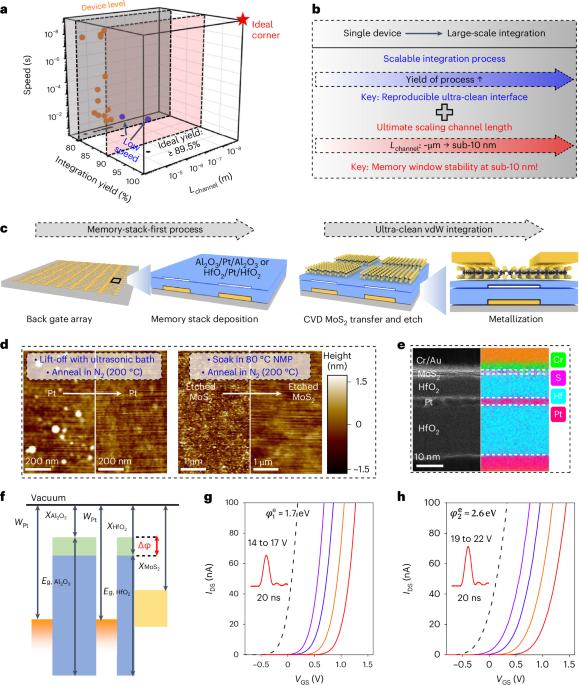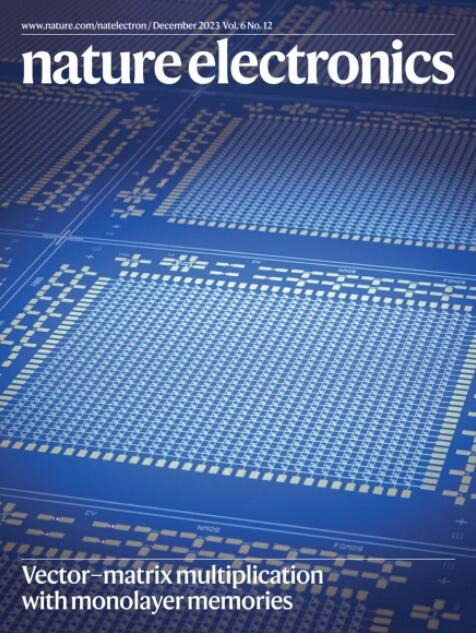A scalable integration process for ultrafast two-dimensional flash memory
IF 33.7
1区 工程技术
Q1 ENGINEERING, ELECTRICAL & ELECTRONIC
引用次数: 0
Abstract
Data-driven computing is highly dependent on memory performance. Flash memory is presently the dominant non-volatile memory technology but suffers from limitations in terms of speed. Two-dimensional (2D) materials could potentially be used to create ultrafast flash memory. However, due to interface engineering problems, ultrafast non-volatile performance is presently restricted to exfoliated 2D materials, and there is a lack of performance demonstrations with short-channel devices. Here, we report a scalable integration process for ultrafast 2D flash memory that can be used to integrate 1,024 flash-memory devices with a yield of over 98%. We illustrate the approach with two different tunnelling barrier configurations of the memory stack (HfO2/Pt/HfO2 and Al2O3/Pt/Al2O3) and using transferred chemical vapour deposition-grown monolayer molybdenum disulfide. We also show that the channel length of the ultrafast flash memory can be scaled down to sub-10 nm, which is below the physical limit of silicon flash memory. Our sub-10 nm devices offer non-volatile information storage (up to 4 bits) and robust endurance (over 105). A scalable integration process for ultrafast two-dimensional flash memory can be used to integrate 1,024 devices with a yield of over 98%. The channel length of the devices could also be scaled down to sub-10 nm.


用于超快二维闪存的可扩展集成工艺
数据驱动型计算高度依赖内存性能。闪存是目前最主要的非易失性存储器技术,但在速度方面受到限制。二维(2D)材料可用于制造超快闪存。然而,由于界面工程问题,超快非易失性性能目前仅限于剥离的二维材料,而且缺乏短通道器件的性能演示。在此,我们报告了一种可扩展的超快二维闪存集成工艺,该工艺可用于集成 1,024 个闪存器件,成品率超过 98%。我们利用存储器堆栈的两种不同隧穿势垒配置(HfO2/Pt/HfO2 和 Al2O3/Pt/Al2O3)以及转移化学气相沉积生长的单层二硫化钼来说明这种方法。我们还表明,超快闪存的沟道长度可缩小到 10 纳米以下,低于硅闪存的物理极限。我们的 10 纳米以下器件可提供非易失性信息存储(高达 4 位)和强大的耐用性(超过 105)。
本文章由计算机程序翻译,如有差异,请以英文原文为准。
求助全文
约1分钟内获得全文
求助全文
来源期刊

Nature Electronics
Engineering-Electrical and Electronic Engineering
CiteScore
47.50
自引率
2.30%
发文量
159
期刊介绍:
Nature Electronics is a comprehensive journal that publishes both fundamental and applied research in the field of electronics. It encompasses a wide range of topics, including the study of new phenomena and devices, the design and construction of electronic circuits, and the practical applications of electronics. In addition, the journal explores the commercial and industrial aspects of electronics research.
The primary focus of Nature Electronics is on the development of technology and its potential impact on society. The journal incorporates the contributions of scientists, engineers, and industry professionals, offering a platform for their research findings. Moreover, Nature Electronics provides insightful commentary, thorough reviews, and analysis of the key issues that shape the field, as well as the technologies that are reshaping society.
Like all journals within the prestigious Nature brand, Nature Electronics upholds the highest standards of quality. It maintains a dedicated team of professional editors and follows a fair and rigorous peer-review process. The journal also ensures impeccable copy-editing and production, enabling swift publication. Additionally, Nature Electronics prides itself on its editorial independence, ensuring unbiased and impartial reporting.
In summary, Nature Electronics is a leading journal that publishes cutting-edge research in electronics. With its multidisciplinary approach and commitment to excellence, the journal serves as a valuable resource for scientists, engineers, and industry professionals seeking to stay at the forefront of advancements in the field.
 求助内容:
求助内容: 应助结果提醒方式:
应助结果提醒方式:


